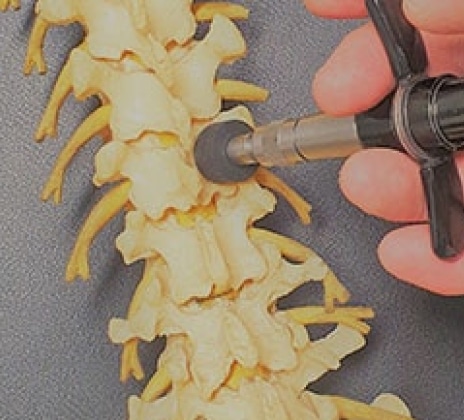Activator Therapy
Low-force instrument-assisted adjustments designed for comfort and precision.
Low-force instrument-assisted adjustments designed for comfort and precision.
Activator therapy uses a handheld instrument to deliver precise, low-force adjustments. It’s ideal for patients who prefer gentle treatment or have sensitive joints. At Our Chiro Brisbane, activator care helps improve joint motion and reduce stiffness while maintaining comfort and accuracy.
Activator therapy is a gentle, low-force chiropractic technique that uses a handheld spring-loaded instrument called an Activator Adjusting Instrument to restore joint motion and reduce pain. Instead of a manual thrust, the Activator delivers a quick, controlled impulse to specific points along the spine or extremities. At Our Chiro Brisbane, this method is used for patients who prefer a lighter touch or when a more precise adjustment is needed.
The instrument’s speed allows the adjustment to occur before surrounding muscles can tighten, helping to reduce resistance and improve comfort. It is often used to restore normal movement patterns, reduce irritation, and support neuromuscular balance. This makes it suitable for people of all ages, including those with acute pain, chronic stiffness, or conditions where manual adjustments may not be ideal.
Activator therapy may assist with:
At Our Chiro Brisbane, activator therapy is applied as part of a tailored treatment plan. Chiropractors assess joint movement and muscle tone before selecting specific areas for adjustment. The approach combines precision, comfort, and consistency to support recovery and long-term spinal health.







Activator therapy is a low force technique that uses a handheld tool to deliver gentle impulses to the spine and other joints. This helps to improve range of motion and mobilise the joints.
Activator therapy can be beneficial for people with certain medical conditions, younger patients, or those who prefer an alternative to manual therapy or manual adjustment techniques.
Activator therapy has been shown to be effective in treating back pain, neck pain, and trigger points. www.pubmed.ncbi.nlm.nih.gov/22457541/
The number of sessions needed will vary depending on the patient’s condition being treated and the individual patient’s response to treatment.
Yes, activator therapy is a safe and effective treatment option for many biomechanical joint problems.
No, activator therapy is a gentle treatment option that should not cause pain or discomfort.
An activator therapy session usually lasts between 15-20 minutes.
The frequency of sessions will depend on the condition being treated and the individual patient’s response to treatment.
During an activator therapy session, the practitioner will use a handheld tool to deliver gentle impulses to the spine and other joints. The number of impulses and the specific areas treated will be based on the condition being treated and the individual patient’s response to treatment.
The cost of activator therapy with one of our chiropractors is available on our fee schedule which can be found at www.ourchiro.com.au or call our reception on 07 3257 0399.
Activator therapy is usually covered by insurance when treatment is provided from a chiropractor.
There are very few risks associated with activator therapy, and it is generally considered to be a safe low force treatment option. However, as with any treatment, there is always a small risk of adverse effects such as soreness.
Activator therapy may be a good treatment option for you if you have certain medical conditions, younger patients, or those who prefer an alternative to manual therapy techniques. Talk to your chiropractor to see if activator therapy is right for you.
Activator Therapy is a low-force chiropractic technique that uses a small, handheld instrument called an Activator Adjusting Instrument. This device delivers a quick, controlled impulse to specific joints or muscles to help improve movement and alignment without the twisting or manual pressure often associated with traditional spinal adjustments.
The Activator method is based on the idea that precise, gentle adjustments can help restore normal joint motion and reduce irritation within the nervous system. The instrument’s speed allows for a focused correction with minimal discomfort or muscle resistance, making it suitable for people who prefer a lighter approach to chiropractic care.
During a session, your Our Chiro chiropractor first assesses the spine or affected area, identifying segments that may be restricted or misaligned. The Activator is then applied to these points, producing a brief tapping sensation. The goal is to encourage natural movement in the joint, helping to reduce tension and promote balance within surrounding muscles and soft tissues.
Activator Therapy can be beneficial for a wide range of people, including older adults, children, or anyone recovering from injury who may need a gentler style of adjustment. It is also useful for addressing localised issues in areas such as the neck, back, or extremities where precision is important.
Some individuals report feeling more relaxed or mobile after treatment, as the technique helps reduce stiffness and supports the body’s natural ability to maintain alignment. While Activator Therapy is not intended to diagnose or treat specific medical conditions, it can play a supportive role in a broader chiropractic care plan aimed at improving comfort, posture, and everyday function.



What does a chiropractor do?
A chiropractor diagnoses and treats musculoskeletal conditions, which involve the joints, muscles, and neural tissue throughout the body. Chiropractors typically use adjustments to help restore joint function and relieve pressure on surrounding tissues.
We commonly see patients with headaches, migraines, back pain, neck pain, mid-thoracic pain, knee pain, or shoulder pain—often from sport or postural issues.
During a typical consultation, you’ll come in for a medical history review, followed by an orthopaedic examination and, if needed, a neurological exam. We’ll then perform a physical assessment to identify the cause of your condition. Imaging such as X-rays or MRI scans may be requested, usually through an external provider.
Treatment often includes gentle adjustments or joint mobilisations to restore movement and reduce pain. We may also use other therapies such as dry needling, Kinesio taping, rigid taping, or soft tissue work as part of your care plan.
Prefer a gentle, low-force approach? Book an Activator Therapy session at Our Chiro Brisbane and experience precise spinal care that feels comfortable.